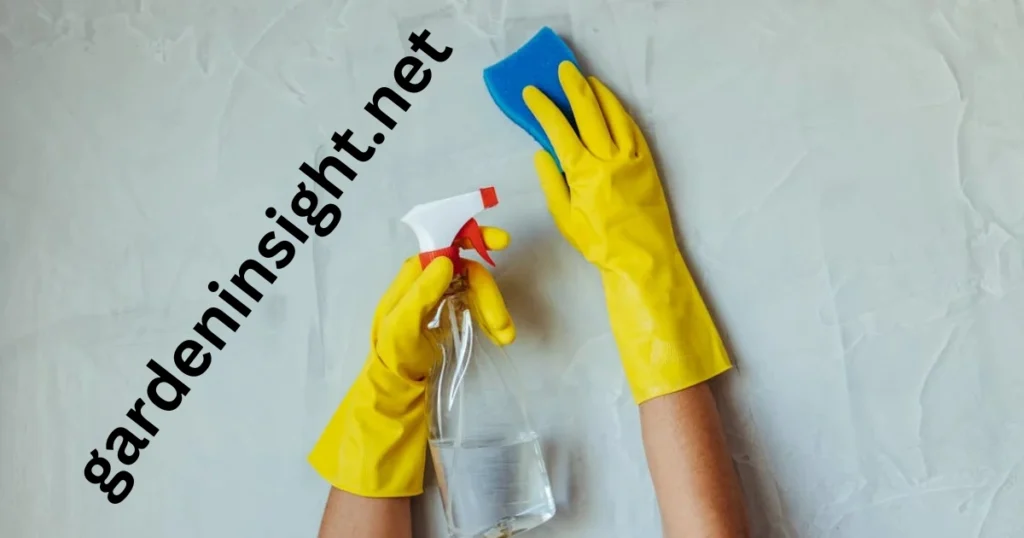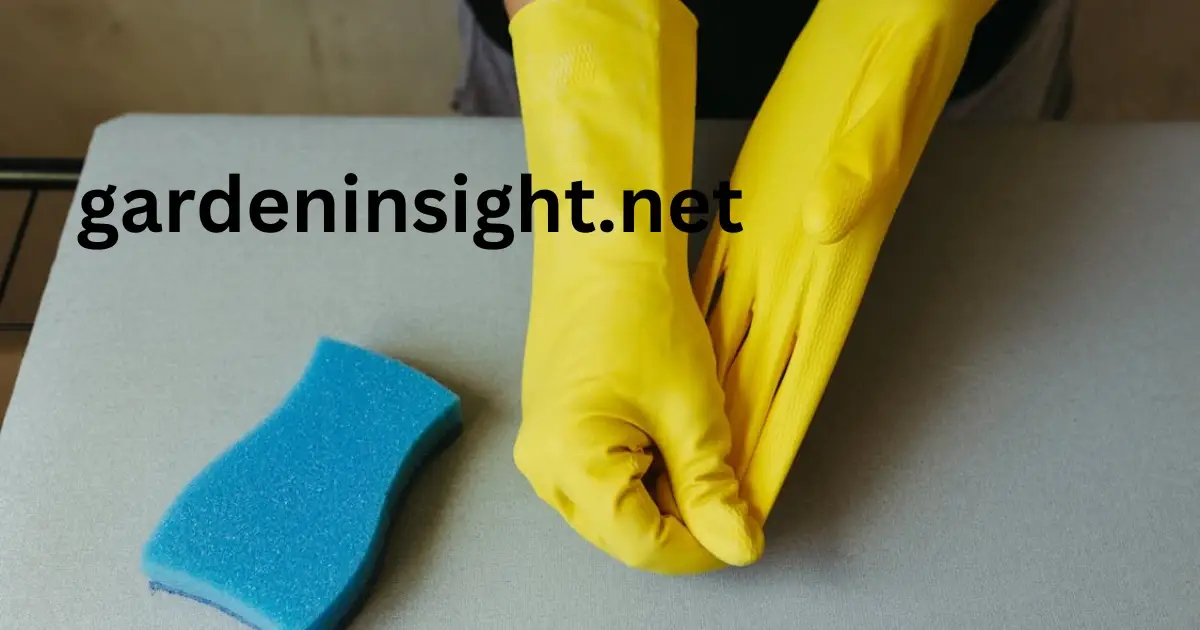Gardening gloves are essential tools for protecting your hands, but they can quickly become grimy with dirt, bacteria, and even harmful substances.
Let ‘s get insights into the eco-friendly washing techniques, addressing different fabric glove materials and offering solutions to common cleaning challenges.
Why is Washing Your Gardening Gloves Important?

Gardening is a rewarding activity, but it can also expose your hands to dirt, grime, and harmful bacteria. Washing your gardening gloves regularly is crucial for several reasons:
- Protecting Your Health: Gardening gloves can harbor bacteria, fungi, and other microorganisms that can cause skin irritations, allergies, or even infections. Washing them helps remove these harmful pathogens.
- Preventing Cross-Contamination: If you’re working with different plants or soil types, your gloves can transfer diseases and pests between them. Washing helps prevent cross-contamination and keeps your garden healthy.
- Maintaining Glove Quality: Dirt and grime can degrade the materials of your gloves, reducing their lifespan. Regular cleaning helps maintain their quality and flexibility.
- Avoiding Odors: Sweat and bacteria can build up in your gloves, leading to unpleasant odors. Washing them keeps them fresh and ready for your next gardening session.
How Often Should You Wash Your Gardening Gloves?
The frequency of washing depends on several factors, including:
- Frequency of Use: If you garden daily, you’ll need to wash your gloves more often than someone who gardens occasionally.
- Types of Activities: Handling fertilizers, chemicals, or diseased plants requires more frequent washing.
- Material of Gloves: Some materials, like leather, require less frequent washing than others.
As a general rule, it’s a good idea to wash your gardening gloves at least once a month. However, if they are visibly dirty, smell bad, or have come into contact with harmful substances, wash them immediately.
Washing Guidelines by Frequency
| Type of Gardening Gloves | Suggested Washing Frequency | Notes |
|---|---|---|
| Cotton/Fabric | After each use or weekly | Easy to machine wash |
| Leather | Monthly or as needed | Requires careful handling to avoid damage |
| Rubber/Nitrile | Weekly or biweekly | Quick rinse after use also recommended |
| Synthetic | Every 2-3 uses or as needed | Check care label for machine washability |
How to Wash Gardening Gloves
Washing your gardening gloves is a simple process. Here’s a step-by-step guide:
- Prepare your gloves: Remove any loose dirt or debris by shaking the gloves or using a brush.
- Check the care label: Different materials have different washing requirements. Always check the care label for specific instructions.
- Hand washing: For most gardening gloves, hand washing is the safest method. Use lukewarm water and a mild detergent. Gently scrub the gloves, paying attention to the areas that come into contact with your skin.
- Machine washing: Some gloves can be machine washed. Place them in a mesh laundry bag to protect them and use a gentle cycle with cold water.
- Rinse thoroughly: Rinse the gloves thoroughly with clean water to remove all soap residue.
- Dry properly: Avoid wringing or twisting the gloves. Gently squeeze out excess water and lay them flat to dry or hang them in a well-ventilated area. Avoid direct sunlight or heat, which can damage the material.
Washing Implications for Different Fabrics

Different glove materials require specific care. Here’s a breakdown:
| Material | Washing Instructions | Drying Instructions |
|---|---|---|
| Cotton | Machine wash or hand wash in warm water | Air dry or tumble dry low |
| Leather | Hand wash with mild soap and lukewarm water | Air dry away from direct sunlight |
| Rubber | Hand wash with warm soapy water | Air dry |
| Synthetic fabrics (nylon, polyester) | Machine wash or hand wash in cold water | Air dry or tumble dry low |
| Waterproof materials (Gore-Tex) | Hand wash with mild soap and cold water | Air dry |
What are the Best Ways to Disinfect Gardening Gloves?
Disinfecting your gardening gloves is essential to kill harmful bacteria and fungi. Here are some effective methods:
- Bleach solution: Soak the gloves in a solution of one part bleach to ten parts water for 30 minutes. Rinse thoroughly.
- Vinegar solution: Soak the gloves in a solution of equal parts water and white vinegar for 30 minutes. Rinse thoroughly.
- Isopropyl alcohol: Wipe down the gloves with isopropyl alcohol. Allow them to air dry.
How to Remove Sap/Dirt/Oil from Gardening Gloves

Gardening can lead to stubborn stains on your gloves. Here’s how to tackle common culprits:
- Sap: Rub the sap stain with rubbing alcohol or a commercial sap remover.
- Dirt: Pre-soak the gloves in a solution of oxygen bleach and water before washing.
- Oil: Use a degreasing dish soap or a laundry stain remover specifically designed for oil.
How to Dry Gardening Gloves Properly
Proper drying is crucial to prevent mildew and maintain the shape of your gloves. Here are some tips:
- Avoid direct sunlight: Sunlight can fade and damage the material.
- Don’t use heat: High heat can shrink or warp the gloves.
- Air dry: Lay the gloves flat on a clean towel or hang them in a well-ventilated area.
- Turn them inside out: This helps ensure that the inside of the gloves dries completely.
Drying Tips
| Glove Material | Drying Method | Precautions |
|---|---|---|
| Cotton/Fabric | Air dry, avoid high heat | Use a towel to absorb excess water |
| Leather | Air dry, avoid sunlight | Prevents cracking and stiffening |
| Rubber/Nitrile | Air dry | Quick drying due to synthetic nature |
How to Store Gardening Gloves to Prevent Mildew
Proper storage is essential to prevent mildew and keep your gloves in good condition.
- Clean and dry: Make sure the gloves are clean and completely dry before storing them.
- Well-ventilated area: Store them in a cool, dry, and well-ventilated area.
- Avoid plastic bags: Plastic bags can trap moisture and promote mildew growth.
- Use a breathable container: Store the gloves in a breathable container, such as a mesh bag or a cardboard box.
Eco-Friendly Glove Washing Solutions
For environmentally conscious gardeners, here are some eco-friendly washing solutions:
- Use a natural detergent: Choose a detergent made with plant-based ingredients and free of harsh chemicals.
- Reduce water usage: Hand wash your gloves in a basin instead of running water.
- Line dry: Air drying your gloves saves energy and reduces your carbon footprint.
- Make your own cleaning solution: Use baking soda, vinegar, or lemon juice to create natural cleaning solutions.
Gardening Gloves Problems: Stains, Odors, and Wear
Here are some solutions to common gardening glove problems:
- Stains: For stubborn stains, try using a paste of baking soda and water. Apply it to the stain, let it sit for a few minutes, and then wash the gloves as usual.
- Odors: To remove odors, soak the gloves in a solution of baking soda and water or white vinegar and water.
- Wear and tear: Reinforce worn areas with patches or stitching. If the gloves are beyond repair, consider repurposing them or disposing of them responsibly.
Maintaining Flexibility and Dexterity Through Washing
To maintain the flexibility and dexterity of your gardening gloves, follow these tips:
- Avoid harsh detergents: Harsh detergents can strip the gloves of their natural oils, making them stiff.
- Condition leather gloves: After washing, apply a leather conditioner to keep the material supple.
- Store properly: Proper storage helps prevent the gloves from becoming misshapen.
Mastering how to wash gardening gloves properly ensures their longevity and protects your hands.
By following these simple steps for how to wash gardening gloves, you can enjoy clean, comfortable, and effective gardening gloves for seasons to come.
FAQs
Can I use the washing machine to clean my gardening gloves?
While some gardening gloves are machine washable, it’s generally recommended to hand wash them. Machine washing can be harsh on certain materials and may damage the gloves. Always check the care label for specific instructions. If machine washing is allowed, use a gentle cycle with cold water and place the gloves in a mesh laundry bag for protection.
How do I get rid of the smell from my gardening gloves?
Smelly gardening gloves are a common problem. To combat odors, you can:
- Soak in baking soda solution: Mix a tablespoon of baking soda with a liter of water and soak the gloves for 30 minutes.
- Use white vinegar: Soak the gloves in a solution of equal parts water and white vinegar for 30 minutes.
- Air dry thoroughly: Make sure the gloves dry completely after washing, as trapped moisture can contribute to odors.
How do you wash gardening gloves with poison ivy?
If your gloves have come into contact with poison ivy, it’s crucial to wash them carefully to avoid spreading the urushiol oil that causes the rash.
- Wear disposable gloves: Protect your hands by wearing disposable gloves while handling the contaminated gardening gloves.
- Wash separately: Wash the gloves separately from other laundry.
- Use hot water: Use hot water and a strong detergent.
- Rinse thoroughly: Rinse the gloves multiple times to ensure all traces of urushiol oil are removed.
- Dry separately: Dry the gloves separately from other laundry.
How to clean really dirty gardening gloves?
For heavily soiled gardening gloves, pre-soaking can help loosen dirt and grime. You can:
- Soak in oxygen bleach: Mix oxygen bleach with water according to the product instructions and soak the gloves for at least 30 minutes.
- Use a pre-wash stain remover: Apply a laundry stain remover to heavily soiled areas before washing.
- Scrub with a brush: Use a soft-bristled brush to scrub away stubborn dirt.
How do you wash leather gardening gloves?
Leather gardening gloves require special care. Here’s how to wash them:
- Hand wash only: Never machine wash leat
- her gardening gloves.
- Use mild soap: Use a mild soap
